|
SULPHUR
OXIDES
Pleas use our
A-Z INDEX to
navigate this site
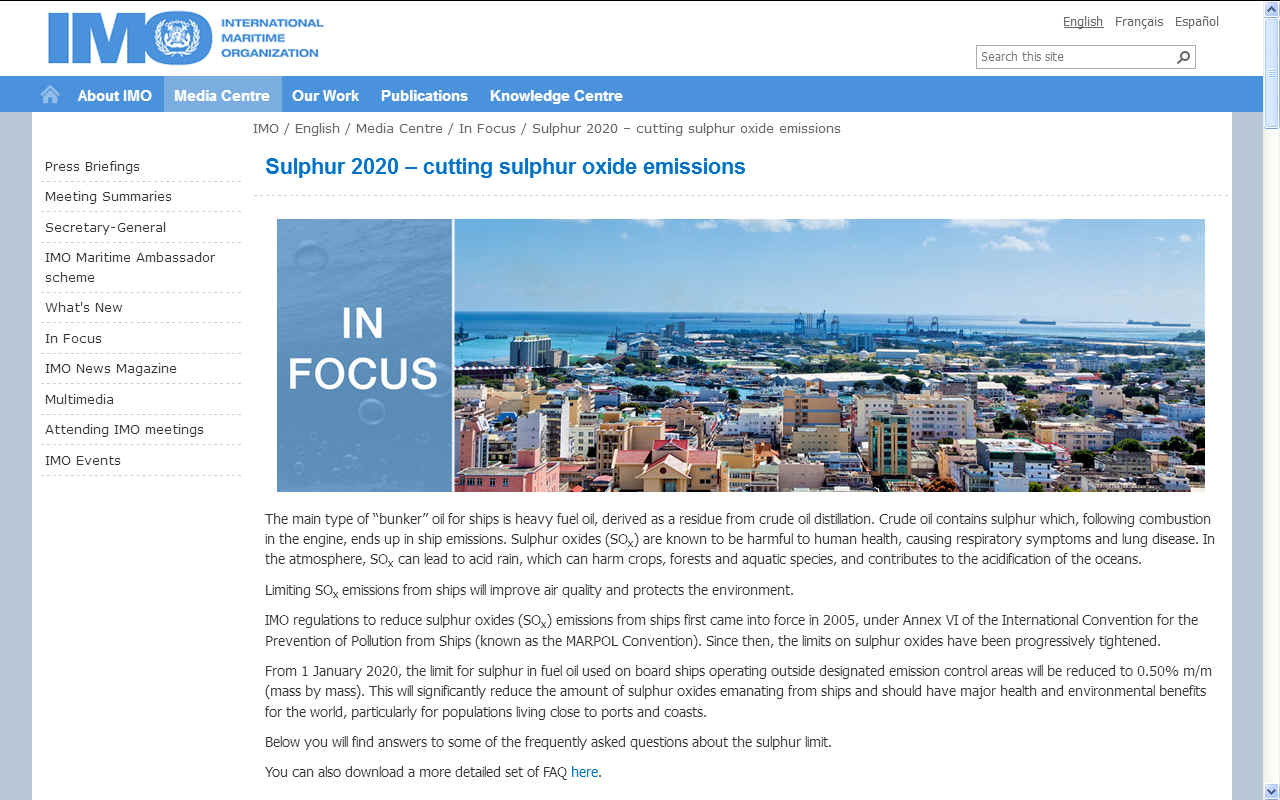
EPA’s national ambient air quality standards for SO2 are designed to protect against exposure to the entire group of sulfur oxides (SOx). SO2 is the component of greatest concern and is used as the indicator for the larger group of gaseous sulfur oxides (SOx). Other gaseous SOx (such as SO3) are found in the atmosphere at concentrations much lower than SO2.
The largest source of SO2 in the atmosphere is the burning of fossil fuels by power plants and other industrial facilities. Smaller sources of SO2 emissions include: industrial processes such as extracting metal from ore; natural sources such as volcanoes; and locomotives, ships and other vehicles and heavy equipment that burn fuel with a high sulfur content.
Human activities such as
agriculture,
fuel
combustion and industrial processes are increasing the amount of sulfurous
oxides in the atmosphere with catastrophic results in the acidification
of our oceans and air pollution that is harmful to humans.
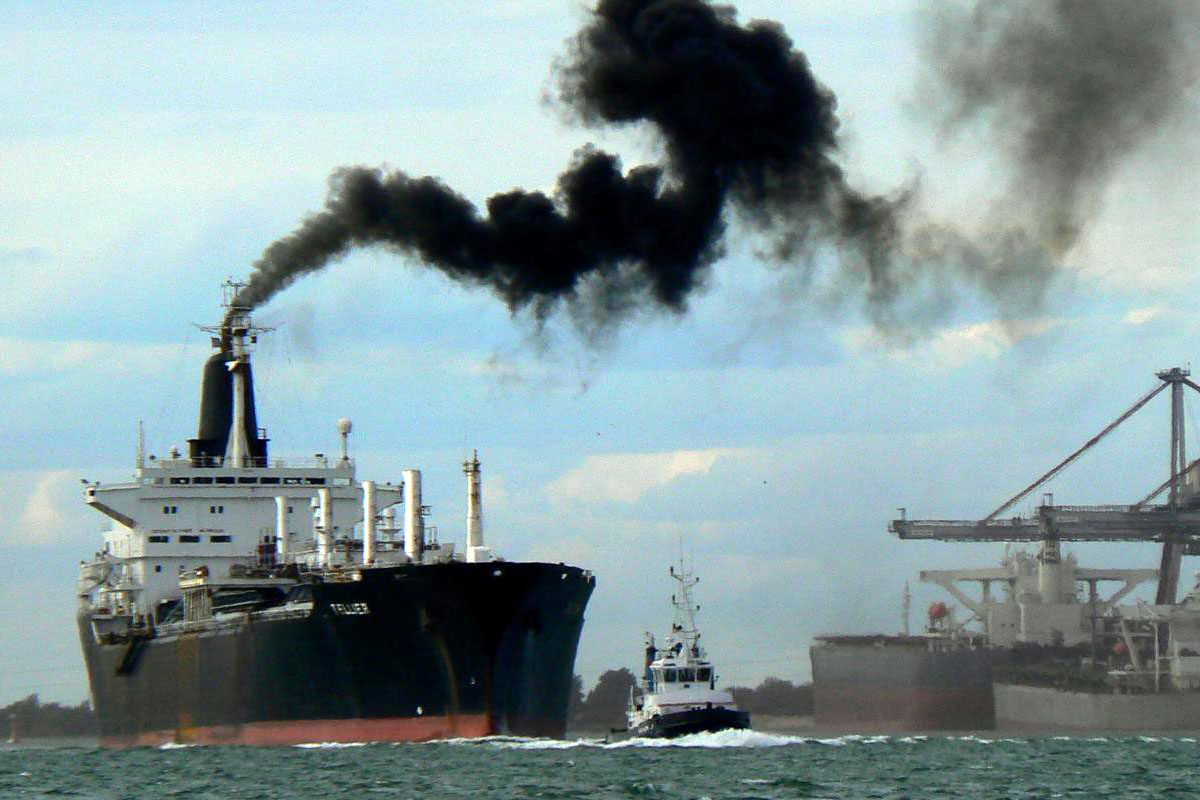
Sulfur (sulphur) dioxide is the chemical compound with the formula SO2. It is a toxic gas responsible for the smell of burnt matches. It is released naturally by
volcanic activity and is produced as a by-product of copper extraction and the burning of fossil fuels contaminated with sulfur compounds.
Sulfur dioxide is an intermediate in the production of sulfuric acid, being converted to sulfur trioxide, and then to oleum, which is made into sulfuric acid. Sulfur dioxide for this purpose is made when sulfur combines with oxygen. The method of converting sulfur dioxide to sulfuric acid is called the contact process. Several billion kilograms are produced annually for this purpose.
On other planets, it can be found in various concentrations, the most significant being the atmosphere of Venus, where it is the third-most significant atmospheric gas at 150 ppm. There, it condenses to form clouds, and is a key component of chemical reactions in the planet's atmosphere and contributes to
global warming. It has been implicated as a key agent in the warming of early Mars, with estimates of concentrations in the lower atmosphere as high as 100 ppm, though it only exists in trace amounts. On both Venus and Mars, as on
Earth, its primary source is thought to be volcanic. The atmosphere of Io, a natural satellite of Jupiter, is 90% sulfur dioxide and trace amounts are thought to also exist in the atmosphere of Jupiter.
AIR POLLUTION
Sulfur dioxide is a major air pollutant and has significant impacts upon human
health. In addition, the concentration of sulfur dioxide in the atmosphere can influence the habitat suitability for plant communities, as well as animal
life.
Sulfur dioxide emissions are a precursor to acid rain and atmospheric particulates. Due largely to the US EPA’s
Acid Rain Program, the U.S. has had a 33% decrease in emissions between 1983 and 2002. This improvement resulted in part from flue-gas desulfurization, a technology that enables SO2 to be chemically bound in power plants burning sulfur-containing coal or oil. In particular, calcium oxide (lime) reacts with sulfur dioxide to form calcium sulfite:
CaO + SO2 → CaSO3
Fuel additives such as calcium additives and magnesium carboxylate may be used in marine
diesel engines to lower the emission of sulfur dioxide gases into the
atmosphere.
As of 2006, China was the world's largest sulfur dioxide polluter, with 2005 emissions estimated to be 25,490,000 short tons (23.1 Mt). This amount represents a 27% increase since 2000, and is roughly comparable with U.S. emissions in 1980.

OCEAN
DEGRADATION - The
more acid our oceans, the more marine life diminishes to the point where
oxygen creating phytoplankton may no longer produce this life sustaining
gas. Ocean degradation includes plastic
pollution.
Another menace making the seas less life sustaining.
IMO
SULPHUR 2020 - CUTTING SOx EMISSIONS
The main type of “bunker” oil for ships is heavy fuel oil, derived as a residue from crude oil distillation. Crude oil contains sulphur which, following combustion in the engine, ends up in ship emissions. Sulphur oxides (SOx) are known to be harmful to human health, causing respiratory symptoms and lung disease. In the atmosphere, SOx can lead to acid rain, which can harm crops, forests and aquatic species, and contributes to the acidification of the oceans.
Limiting SOx emissions from ships will improve air quality and protects the environment.
IMO regulations to reduce sulphur oxides (SOx) emissions from ships first came into force in 2005, under Annex VI of the International Convention for the Prevention of Pollution from Ships (known as the MARPOL Convention). Since then, the limits on sulphur oxides have been progressively tightened.
From 1 January 2020, the limit for sulphur in fuel oil used on board ships operating outside designated emission control areas will be reduced to 0.50% m/m (mass by mass). This will significantly reduce the amount of sulphur oxides emanating from ships and should have major health and environmental benefits for the world, particularly for populations living close to ports and coasts.
Below you will find answers to some of the frequently asked questions about the sulphur limit.
Symposium on IMO 2020 and Alternative Fuels (17-18 October 2019)
IMO is hosting a Symposium on IMO 2020 and Alternative Fuels on Thursday, 17 October and Friday, 18 October 2019 in the Main Hall at
IMO Headquarters. This one and half day symposium aims to raise awareness and to take stock of the preparations for the IMO 2020 rule, and to discuss the role of alternative fuels in the
decarbonization of international
shipping.
The Symposium will be live-streamed and remote participation is open to Member Governments, IGOs, NGOs and the general public.
Member Governments, IGOs, NGOs can register delegates to attend the symposium. The symposium is also open to delegates who wish to attend the symposium but who are not affiliated with an IMO delegation.
Further details and a provisional agenda can be found in Circular letter
No.3998.
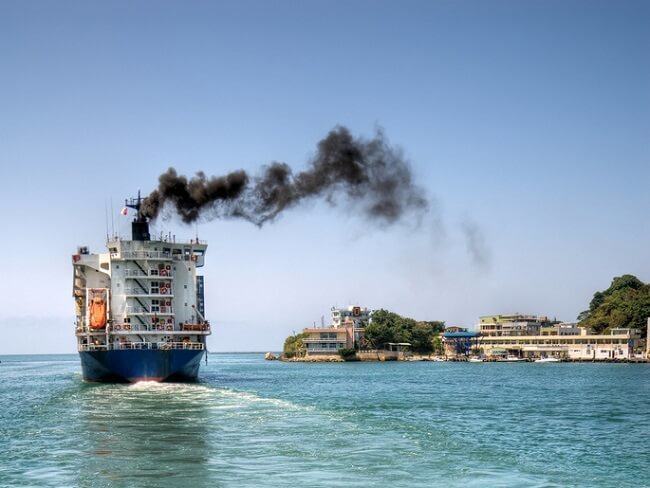
Limiting SOx emissions from ships will have a very positive impact on human health: how does that work?
Simply put, limiting sulphur oxides emissions from ships reduces air pollution and results in a cleaner environment. Reducing SOx also reduces particulate matter, tiny harmful particles which form when fuel is burnt.
A study on the human health impacts of SOx emissions from ships, submitted to IMO’s Marine Environment Protection Committee (MEPC) in 2016 by Finland, estimated that by not reducing the SOx limit for ships from 2020, the air pollution from ships would contribute to more than 570,000 additional premature deaths worldwide between 2020-2025.
Why are ships already less harmful than other forms of transport?
Ships do emit pollutants and other harmful emissions. But they also transport large quantities of vital goods across the world’s oceans – and seaborne trade continues to increase. In 2016, ships carried more than 10 billion tons of trade for the first time, according to UNCTAD.
So ships have always been the most sustainable way to transport commodities and goods. And ships increasingly becoming even more energy efficient. IMO regulations on energy efficiency support the demand for ever greener and cleaner shipping. A ship which is more energy efficient burns less fuel so emits less air pollution.
It has sometimes been quoted that just a few ships (all using fuel
oil with maximum permitted sulphur content) emit as much harmful air pollutants as all the cars in the world (if the cars were all using the cleanest fuel available).
Not only is this the very worst case scenario, but this does not take into account the amount of cargo that is being carried by those ships and the relative efficiency. It is important to consider the amount of cargo carried and the emissions per tonne of cargo carried, per kilometre travelled. Studies have shown that ships are by far the most energy-efficient form of transportation, compared with other modes such as aviation, road trucks and even railways.
It is also relevant to remember that shipping responds to the demands of world trade. As world trade increases, more ship capacity will be needed.
How can ships carry so much cargo so efficiently?
Ships are the largest machines on the planet and the world’s largest diesel engines can be found on cargo ships. These engines can be as tall as a four-storey house, and as wide as three London buses. The largest marine
diesel engines have more than 100,000 horsepower (in comparison, a mid-sized car may have up to 300 horsepower).
But the largest container ships can carry more than 20,000 containers and the biggest bulk carriers can carry more than 300,000 tons of commodities, like iron ore.
So powerful engines are needed to propel a ship through the sea. And it is important to consider how much energy is used to carry each ton of cargo per kilometre. When you look at the relative energy efficiency of different modes of transport, ships are by far the most energy efficient.
Ships can reduce air pollutants by being even more energy efficient, so they burn less fuel and therefore their emissions are lower.
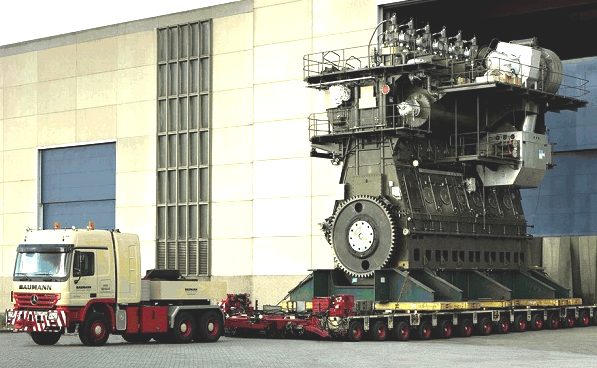
State
of the art Wartsila diesel engines for oil tankers and cruise
liners may soon become an outdated technology as solar and
wind powered vessels become economically viable due to clean
air laws. Our patent energy harvesting system may soon herald
in zero carbon cargo vessels and cruise liners.
What is the current regulation on SOx in ships emissions and by how much is that going to be improved?
We are going to see a substantial cut: to 0.50% m/m (mass by mass) from 3.50% m/m.
For ships operating outside designated emission control areas the current limit for sulphur content of ships’ fuel oil is 3.50% m/m.
The new limit will be 0.50% m/m which will apply on and after 1 January 2020.
There is an even stricter limit of 0.10% m/m already in effect in emission control areas (ECAS) which have been established by IMO. This 0.10% m/m limit applies in the four established ECAS: the Baltic Sea area; the North Sea area; the North American area (covering designated coastal areas off the United States and Canada); and the United States Caribbean Sea area (around Puerto Rico and the United States Virgin Islands).
(Countries bordering the Mediterranean Sea are currently considering the possibility of applying to designate the Mediterranean Sea or parts thereof as an
ECA.)
Fuel oil providers already supply fuel oil which meets the 0.10% m/m limit (such as marine distillate and ultra low sulphur fuel oil blends) to ships which require this fuel to trade in the ECAs.
What must ships do to meet the new IMO regulations?
The IMO MARPOL regulations limit the sulphur content in fuel oil. So ships need to use fuel oil which is inherently low enough in sulphur, in order to meet IMO requirements.
Refineries may blend fuel oil with a high (non-compliant) sulphur content with fuel oil with a sulphur content lower than the required sulphur content to achieve a compliant fuel oil. Additives may be added to enhance other properties, such as lubricity.
Some ships limit the air pollutants by installing exhaust gas cleaning systems, also known as “scrubbers”. This is accepted by flag States as an alternative means to meet the sulphur limit requirement. These scrubbers are designed to remove sulphur oxides from the ship’s engine and boiler exhaust gases. So a ship fitted with a scrubber can use heavy fuel oil, since the sulphur oxides emissions will be reduced to a level equivalent to the required fuel oil sulphur limit.
Ships can have engines which can use different fuels, which may contain low or zero sulphur. For example, liquefied natural gas, or
biofuels.
Are low sulphur blend fuel oils safe? Can new low sulphur fuels cause problems for a ship’s engine?
All fuel oil for combustion purposes on a ship must meet required fuel oil quality standards, as set out in IMO MARPOL Annex VI (regulation 18.3). For example, the fuel oil must not include any added substance or chemical waste that jeopardizes the safety of ships or adversely affects the performance of the machinery.
IMO is currently discussing how to identify any potential safety issues related to new blends of fuel oil as it is recognized that if these fuels are not managed appropriately, there could be compatibility and stability issues. If needed, additional guidance for crew and ship operators could be developed.
An International Standardization Organization (ISO) standard (ISO 8217) specifies the requirements for fuels for use in marine diesel engines and boilers.
How can ship operators and owners to plan ahead for the 0.50% sulphur 2020 limit?
To assist ship operators and owners to plan ahead for the 0.50% sulphur 2020 limit, the MEPC has approved various guidance and guidelines.
The 2019 Guidelines on consistent implementation of 0.50% sulphur limit under MARPOL Annex VI adopted by resolution MEPC.320(74) are available here.
These comprehensive guidelines include a template for a "Fuel Oil Non-Availability Report (FONAR)" set out in Appendix 1 and a "Technical review of identified possible potential safety implications associated with the use of 2020 compliant fuels" set out in appendix 2. (These Guidelines are a non-official version issued in May 2019 and subject to final editorial modifications. But this version is accurate enough in substance for implementation of IMO 2020 sulphur limit. The official version will be issued as part of the final report of MEPC 74 in Summer 2019 at which point the non-official version will be revoked.)
The ship implementation planning guidance includes sections on:
- risk assessment and mitigation plan (impact of new fuels);
- fuel oil system modifications and tank cleaning (if needed);
- fuel oil capacity and segregation capability;
- procurement of compliant fuel;
- fuel oil changeover plan (conventional residual fuel oils to 0.50% sulphur compliant fuel oil); and
documentation and reporting.
Is a FONAR a waiver?
No.
The 2019 Guidelines on consistent implementation of 0.50% sulphur limit under MARPOL Annex VI adopted by resolution MEPC.320(74) here clearly states (in APPENDIX 1):
"3.1 A fuel oil non-availability report is not an exemption. According to regulation 18.2 of MARPOL Annex VI, it is the responsibility of the Party of the destination port, through its competent authority, to scrutinize the information provided and take action, as appropriate."
"3.2 In the case of insufficiently supported and/or repeated claims of non-availability, the Party may require additional documentation and substantiation of fuel oil non-availability claims. The ship/operator may also be subject to more extensive inspections or examinations while in port."
"3.3 Ships/operators are expected to take into account logistical conditions and/or terminal/port policies when planning bunkering, including but not limited to having to change berth or anchor within a port or terminal in order to obtain compliant fuel."
"3.4 Ships/operators are expected to prepare as far as reasonably practicable to be able to operate on compliant fuel oils. This could include, but is not limited to, fuel oils with different viscosity and different sulphur content not exceeding regulatory requirements (requiring different lube oils) as well as requiring heating and/or other treatment on board."
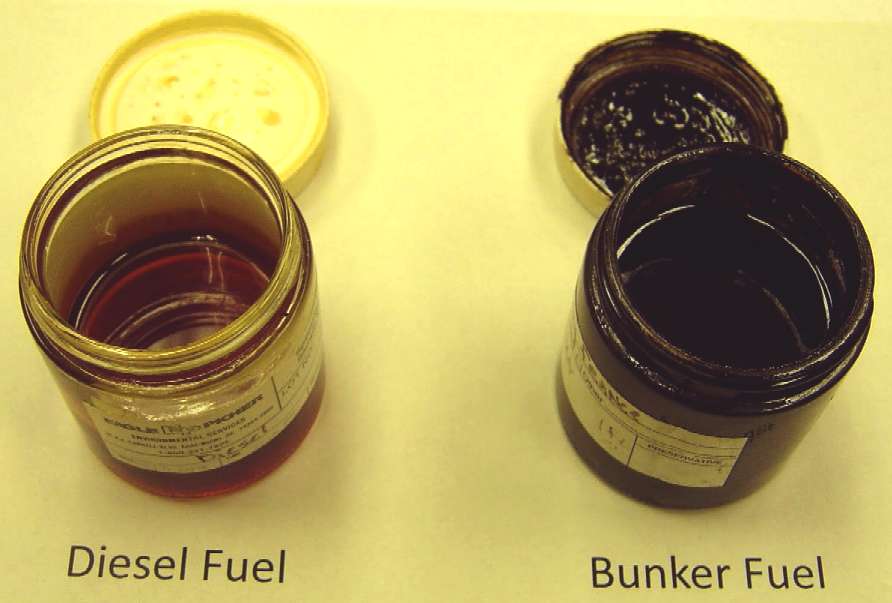
Ships
with more advanced engines can process heavier, more viscous,
and thus cheaper, fuel. Governing bodies (i.e. California,
European Union) around the world have established Emission
Control Areas (ECA) which limit the maximum sulfur of fuels
burned in their ports to limit pollution, reducing the
percentage of sulfur and other particulates from 4.5% m/m to
as little as .10% as of 2015 inside an ECA. As of 2013 3.5%
continued to be permitted outside an ECA. This is where Marine
Distillate Fuels and other alternatives to use of heavy bunker
fuel come into play. They have similar properties to Diesel #2
which is used as road Diesel around the world. The most common
grades used in shipping are DMA and DMB. Greenhouse gas
emissions resulting from the use of international bunker fuels
are currently included in national inventories.
Small
molecules like those in propane, naphtha, gasoline
for cars, and jet
fuel have relatively low boiling points, and they are
removed at the start of the fractional distillation process.
Heavier petroleum products like diesel and lubricating oil are
much less volatile and distill out more slowly, while bunker
oil is literally the bottom of the barrel; the only things
more dense than bunker fuel are carbon black feedstock and
bituminous residue which is used for paving roads (asphalt)
and sealing roofs.
Could the 0.50% limit be delayed?
No. There can be no change in the 1 January 2020 implementation date, as it is too late now to amend the date and for any revised date to enter into force before 1 January 2020.
Will new fuels be needed to meet the 2020 limit? Will there be enough?
It is likely that new blends of fuel oil for ships will be developed, For example, a gas oil, with a very low sulphur content can be blended with heavy fuel oil to lower its sulphur content.
These new blends are likely to cost more initially than the “heavy fuel oil” bunkers (fuel) used by the majority of ships today. Ships can also choose to switch to a different fuel altogether. Or they may continue to purchase
heavy fuel
oil, but install ”scrubbers” to reduce the output of SOx in order to have an equivalent means to meet the requirement.
Of course, some ships are already using low sulphur fuel oil to meet the even more stringent limits of 0.10% m/m when trading in the already-established emission control areas. So those fuel oil blends suitable for ECAS, will also meet the 0.50% m/m limit in 2020. However, there is a cost differential, and these blends are more expensive than heavy fuel oil.
A study commissioned by IMO into the "Assessment of fuel oil availability" concluded that the refinery sector has the capability to supply sufficient quantities of marine fuels with a sulphur content of 0.50% m/m or less and with a sulphur content of 0.10% m/m or less to meet demand for these products, while also meeting demand for non-marine fuels.
Consistent compliance with the new limit is vital. What is IMO doing about that?
Monitoring, compliance and enforcement of the new limit falls to Governments and national authorities of Member States that are Parties to MARPOL Annex VI. Flag States (the State of registry of a ship) and port States have rights and responsibilities to enforce compliance.
IMO is working with Member States as well as industry (including the shipping industry and the bunker supply and refining industry) to identify and mitigate transitional issues so that ships may meet the new requirement.
For example, developing guidance, developing standardised formats for reporting fuel oil non availability if a ship cannot obtain compliant fuel oil and considering verification and control issues.
In October 2018, IMO's Marine Environment Protection Committee (MEPC) adopted a MARPOL amendment to prohibit the carriage of non-compliant fuel oil for combustion purposes for propulsion or operation on board a ship - unless the ship has an exhaust gas cleaning system ("scrubber")
fitted.
The MEPC also approved guidance on ship implementation planning, part of a set of guidelines being developed by IMO for consistent implementation of the MARPOL regulation coming into effect from 1 January 2020.
The MEPC also approved Guidance on best practice for fuel oil suppliers. The Guidance is intended to assist fuel oil purchasers and users in assuring the quality of fuel oil delivered to and used on board ships, with respect to both compliance with the MARPOL requirements and the safe and efficient operation of the ship. The guidance pertains to aspects of the fuel oil purchase up to the loading of the purchased fuel oil on board.
Do small ships have to comply with the sulphur limit from 2020?
Yes, the MARPOL regulations apply to all ships. Only larger ships of 400 gross tonnage and above engaged in voyages to ports or offshore terminals under the jurisdiction of other Parties have to have an International Air Pollution Prevention Certificate, issued by the ship’s flag State. But all sizes of ships will need to use fuel oil that meets the 0.50% limit from 1 January 2020.
Some smaller ships may already be using fuel oil that meets the limit, such as a marine distillate suitable for their engines. (Small ships operating in the already-designated emission control areas will be using fuel oil that meets the 0.10% limit in those emission control areas.)
Does the sulphur limit apply only to ships on international voyages?
The sulphur oxides regulation (MARPOL Annex VI, regulation 14) applies to all ships, whether they are on international voyages, between two or more countries; or domestic voyages, solely within the waters of a Party to the MARPOL Annex.
GREENHOUSE
GASES
The major
greenhouse gases are water vapour, which causes about 36–70% of the greenhouse effect;
carbon dioxide (CO2), which causes 9–26%;
methane (CH4), which causes 4–9%;
nitrous oxide (N2O) that accounts for about 5.6 percent of
greenhouse gas emissions from human
activities and ozone (O3), which causes 3–7%.
The greenhouse effect is the process by which
absorption and emission of infrared radiation by gases in a planet's atmosphere, warm its lower atmosphere and
surface, to include warming the oceans and melting the ice
caps.
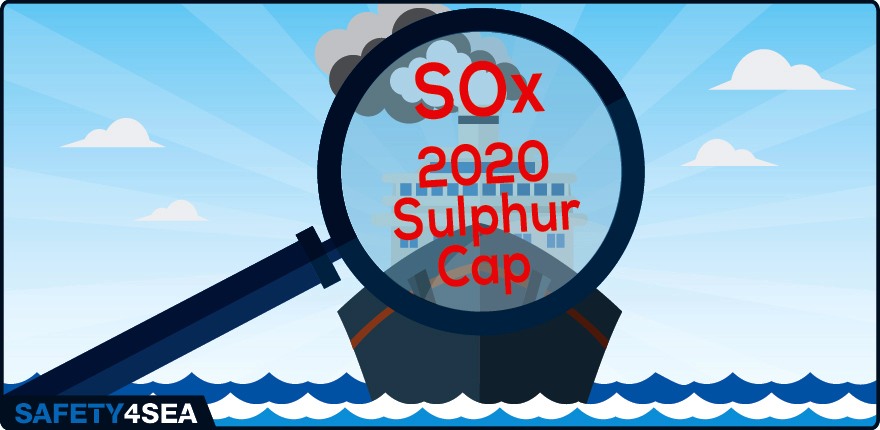
...
LINKS
& REFERENCE
https://www.electricvehiclesresearch.com/articles/6715/tightening-air-pollution-laws-boost-e-ships
https://www.epa.gov/so2-pollution/sulfur-dioxide-basics
http://www.imo.org/en/MediaCentre/HotTopics/Pages/Sulphur-2020.aspx
http://www.idtechex.com/research/reports/electric-boats-small-submarines-and-autonomous-underwater-vehicles-auv-2014-2024-000371.asp
https://www.environment.gov.au/atmosphere/airquality/publications/standards.html

Pleas use our
A-Z INDEX to
navigate this site
This
website is provided on a free basis as a public information service.
copyright © Climate Change Trust 2019. Solar
Studios, BN271RF, United Kingdom.
|






